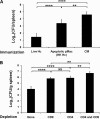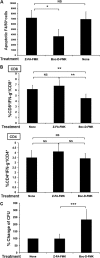Immunization with apoptotic phagocytes containing Histoplasma capsulatum activates functional CD8(+) T cells to protect against histoplasmosis
- PMID: 21911464
- PMCID: PMC3257918
- DOI: 10.1128/IAI.05350-11
Immunization with apoptotic phagocytes containing Histoplasma capsulatum activates functional CD8(+) T cells to protect against histoplasmosis
Abstract
We have previously revealed the protective role of CD8(+) T cells in host defense against Histoplasma capsulatum in animals with CD4(+) T cell deficiency and demonstrated that sensitized CD8(+) T cells are restimulated in vitro by dendritic cells that have ingested apoptotic macrophage-associated Histoplasma antigen. Here we show that immunization with apoptotic phagocytes containing heat-killed Histoplasma efficiently activated functional CD8(+) T cells whose contribution was equal to that of CD4(+) T cells in protection against Histoplasma challenge. Inhibition of macrophage apoptosis due to inducible nitric oxide synthase (iNOS) deficiency or by caspase inhibitor treatment dampened the CD8(+) T cell but not the CD4(+) T cell response to pulmonary Histoplasma infection. In mice subcutaneously immunized with viable Histoplasma yeasts whose CD8(+) T cells are protective against Histoplasma challenge, there was heavy granulocyte and macrophage infiltration and the infiltrating cells became apoptotic. In mice subcutaneously immunized with carboxyfluorescein diacetate succinimidyl ester (CFSE)-labeled apoptotic macrophages containing heat-killed Histoplasma, the CFSE-labeled macrophage material was found to localize within dendritic cells in the draining lymph node. Moreover, depleting dendritic cells in immunized CD11c-DTR mice significantly reduced CD8(+) T cell activation. Taken together, our results revealed that phagocyte apoptosis in the Histoplasma-infected host is associated with CD8(+) T cell activation and that immunization with apoptotic phagocytes containing heat-killed Histoplasma efficiently evokes a protective CD8(+) T cell response. These results suggest that employing apoptotic phagocytes as antigen donor cells is a viable approach for the development of efficacious vaccines to elicit strong CD8(+) T cell as well as CD4(+) T cell responses to Histoplasma infection.
Figures







References
-
- Albert M. L., Sauter B., Bhardwaj N. 1998. Dendritic cells acquire antigen from apoptotic cells and induce class I-restricted CTLs. Nature 392:86–89 - PubMed
-
- Allendörfer R., Brunner G. D., Deepe G. S., Jr 1999. Complex requirements for nascent and memory immunity in pulmonary histoplasmosis. J. Immunol. 162:7389–7396 - PubMed
-
- Bertaux L., et al. 2008. Apoptotic pulsed dendritic cells induce a protective immune response against Toxoplasma gondii. Parasite Immunol. 30:620–629 - PubMed
-
- Chinese-Taipei Society of Laboratory Animal Sciences 2007. Guidebook for the care and use of laboratory animals, 3rd ed. Chinese-Taipei Society of Laboratory Animal Sciences, Taipei, Taiwan
Publication types
MeSH terms
Substances
LinkOut - more resources
Full Text Sources
Medical
Molecular Biology Databases
Research Materials

